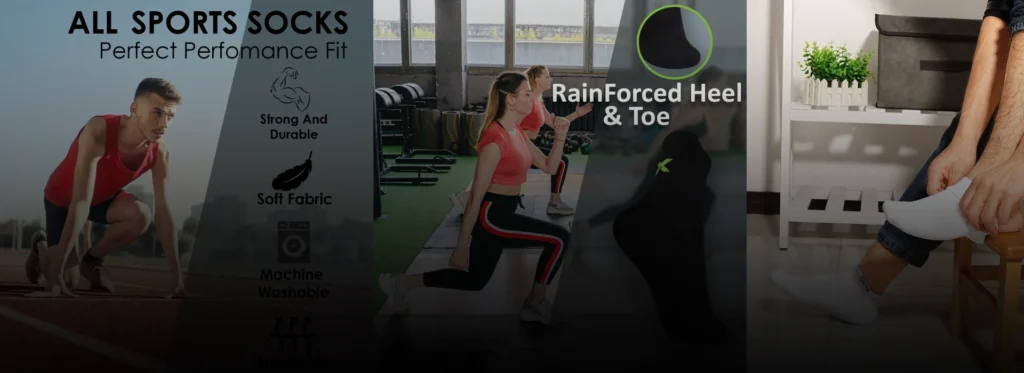When we think of sportswear, our minds often gravitate toward jerseys, shorts, or high-performance shoes. But what about sports socks? This seemingly inconspicuous piece of apparel is crucial in enhancing athletic performance, ensuring comfort, and preventing injuries. Do you truly realize the significance of your sports socks? Let’s delve into why these underrated accessories deserve more attention and how choosing the right pair can elevate your game.
The Unsung Heroes of Athletic Gear
While shoes are often considered the crown jewel of sports equipment, socks are the foundation that can make or break your comfort. Poorly chosen socks can lead to blisters, discomfort, and even serious foot injuries. On the other hand, high-quality sports socks can:
- Provide essential cushioning.
- Wick away moisture to keep your feet dry.
- Offer support to reduce strain during intense activities.
- Enhance overall comfort, allowing you to focus on your performance.
Why Sports Socks Are Different
Sports socks differ significantly from everyday socks. Here are some features that set them apart:
- Moisture-Wicking Materials: Unlike regular cotton socks, sports socks are often made of synthetic blends like polyester, nylon, and spandex. These materials draw sweat away from the skin, preventing dampness and reducing the risk of fungal infections.
- Targeted Cushioning: Sports socks often feature additional padding in high-impact areas, such as the heel and ball of the foot. This cushioning absorbs shock, reducing the risk of injuries during activities like running, jumping, or playing contact sports.
- Arch and Ankle Support: Many sports socks are designed with built-in arch compression and ankle support to minimize strain and provide stability.
- Breathability: Sports socks with mesh panels or vented designs improve airflow, keeping feet cool and comfortable during intense workouts.
- Seamless Design: To prevent chafing and blisters, most sports socks are crafted with seamless construction, ensuring a smooth fit against the skin.
Types of Sports Socks
Different sports demand specific sock designs. Let’s explore some popular types:
- Running Socks: Lightweight with excellent moisture-wicking properties, running socks often include arch support and cushioned soles to reduce impact.
- Cycling Socks: Designed to be thin and breathable, cycling socks help improve aerodynamics while keeping your feet dry.
- Basketball Socks: These are typically longer, offering better ankle support and cushioning to absorb the impact of sudden movements.
- Compression Socks: Ideal for long-distance running or recovery, these socks improve blood circulation and reduce muscle fatigue.
- Soccer Socks: Over-the-calf designs protect against abrasions from shin guards and provide support for intense gameplay.
- Hiking Socks: These feature extra cushioning and thicker materials to provide insulation and prevent blisters during long treks.
The Importance of Fit
One size does not fit all when it comes to sports socks. The wrong size can cause discomfort, bunching, or slippage. Here are some tips to ensure the perfect fit:
- Size Matters: Choose socks that align with your shoe size to prevent excess fabric or tightness.
- Check the Height: Select sock lengths appropriate for your sport and preferences – ankle, crew, or knee-high.
- Test the Stretch: A good sports sock should have adequate stretch for a snug but comfortable fit.
Caring for Your Sports Socks
Proper maintenance can extend the life of your sports socks and ensure optimal performance. Follow these tips:
- Wash socks after each use to remove sweat and bacteria.
- Use mild detergents and avoid fabric softeners, as they can affect moisture-wicking properties.
- Air-dry your socks to maintain their elasticity and prevent shrinkage.
- Replace socks regularly to avoid worn-out fabric compromising their effectiveness.
How to Choose the Right Sports Socks
With so many options available, picking the right pair can feel overwhelming. Consider these factors:
- Activity: Match the socks to your sport’s demands. For instance, a basketball player needs more cushioning and ankle support compared to a cyclist.
- Material: Opt for synthetic blends for moisture-wicking and durability. Avoid cotton, as it retains moisture.
- Fit: Ensure the socks fit well without causing discomfort or restricting movement.
- Weather: For cold conditions, choose socks with thermal insulation. For hot climates, prioritize breathability and moisture-wicking properties.
- Brand Reputation: Trusted brands often invest in research and technology to create high-quality products.
Common Mistakes to Avoid
Even the best sports socks can fall short if misused. Avoid these common mistakes:
- Wearing the Wrong Socks: Using casual socks for sports can lead to discomfort and injuries.
- Ignoring Wear and Tear: Old, worn-out socks lose their supportive and moisture-wicking properties.
- Skipping Sock-Specific Features: Overlooking features like compression or targeted cushioning can impact performance.
Final Thoughts
Sports socks are more than just a minor accessory; they are an integral part of your athletic gear. The right pair can enhance your performance, protect your feet, and provide unmatched comfort. By understanding their importance and choosing wisely, you can elevate your game and keep your feet in top shape.
So, the next time you gear up for a workout or competition, take a moment to realize your sports socks. Give them the recognition they deserve, and they’ll reward you with improved performance and lasting comfort.
Are your sports socks ready to support you on your journey? Make the right choice and step into your next adventure with confidence.
